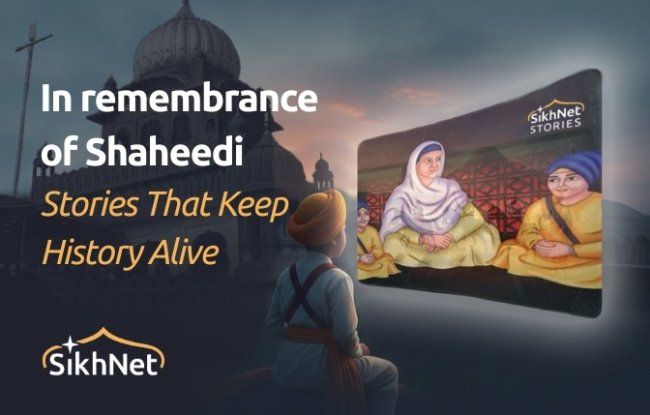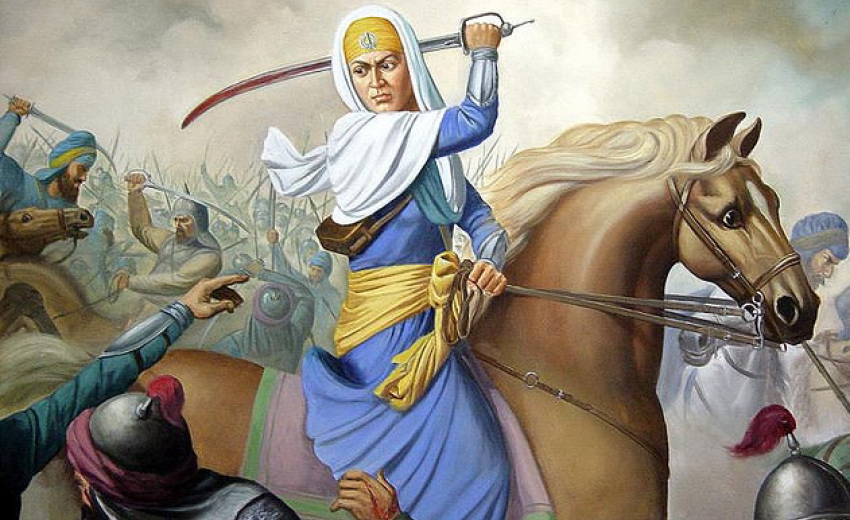Armed with the core Sikh beliefs of equality, humanity, and compassion, these remarkable women paved the way for a more just, equitable, and humane society.
Throughout history, contributions of women have often been overlooked , primarily because the accounts of the past have been recorded predominantly by men.In India, women of the Sikh faith have demonstrated remarkable strength, courage, and leadership for centuries. Despite facing intense patriarchal norms and cultural misogyny, they have fearlessly fought battles, ruled kingdoms, imparted teachings, and selflessly served their communities. These Sikh women have managed large organizations, guided entire communities through turbulent times, and even led formidable revolts against oppressive rulers.
Their remarkable accomplishments are praiseworthy in their own right. However, when viewed through the lens of the deeply entrenched gender discrimination and societal obstacles they had to overcome, their achievements become even more inspiring and deserving of profound admiration. While the stories of some of these trailblazing Sikh women have been preserved, there are undoubtedly many others whose narratives have been lost or forgotten over the passages of time.
This article aims to shed light on 10 iconic and badass Sikh women from history who have left an indelible mark on the world through their courage, resilience, and commitment to the principles of social justice and gender equality. Armed with the core Sikh beliefs of equality, humanity, and compassion, these remarkable women paved the way for a more just, equitable, and humane society. Their powerful legacies continue to inspire and empower generations, serving as a constant reminder of the transformative impact that determined individuals can have in shaping a better world.
(Note: Many of the women have the last name Kaur. They are not necessarily related. Many women of the Sikh faith share the name Kaur as a way to indicate equality and sisterhood. The 10th Sikh Guru, or prophet, asked all Sikhs to adopt a collective name reserved for royal families to signify the inherent equality and nobility of every individual: Kaur for women and Singh for men. This challenged the Indian caste system, in which traditional family last names were used to signify one’s social status, and undermined the patriarchal practices of taking the husband’s name.)
The Freedom Fighter: Gulab Kaur (1890–1941)
Gulab Kaur and her husband Man Singh came from a poor family in Punjab, India. They wanted a better life, so they went to Manila in the Philippines. Their ultimate goal was to migrate to America. While in Manila, Gulab Kaur attended lectures by the Ghadar Party. This was an organization started by Punjabi Indians living abroad. Their aim was to free India from British rule.
Gulab Kaur was inspired to join their movement. She disguised herself as a journalist with a press pass. Using this disguise, she distributed weapons to Ghadar Party members. Gulab Kaur also encouraged more people to join the party. She handed out literature about Indian independence. She gave inspiring speeches to Indian passengers on ships. For her actions against British rule, Gulab Kaur was eventually sentenced to two years in prison in Lahore, which is now part of Pakistan. She was punished for committing seditious acts against the British government ruling India at that time. Gulab risked her freedom to fight for an independent India.
The Bishop-Mayor: Bibi Bhag Bhari (late 1400s–early 1500s)
Bibi Bhag Bhari played an important role in the early Sikh leadership. She was among the first to serve in the Manji system, which was the administrative structure set up in Punjab, India by the Sikh Gurus. The purpose of the Manji system was to keep the Sikh community united and strong across the region.
Bibi Bhag Bhari was appointed as the Manji of Kashmir by Guru Amar Das himself. She was chosen for this influential position because the Guru felt she had a deep understanding of Sikh teachings and principles. In her role, Bibi Bhag Bhari acted as both a spiritual guide and administrative leader for the Sikh community in Kashmir. She oversaw their economic, religious and social matters, working to uphold the faith and keep the community cohesive under Sikh values.
Air Force Pilot: Harita Kaur Deol (1972–1996).
Harita Kaur Deol, a native of Chandigarh, Punjab, made history as one of the first seven women to join the Indian Air Force as Short Service Commission (SSC) officers in 1993. She went on to become the first female pilot to fly solo for the Indian Air Force. At the age of 22, Harita embarked on her first solo flight on September 2, 1994, piloting an Avro HS-748 aircraft. Tragically, her promising career was cut short when she lost her life in an air crash near Nellore on December 25, 1996, at the young age of 25. Harita's pioneering journey paved the way for many women to pursue their dreams of becoming pilots in the Indian Air Force.
The Soup Kitchen Master: Mata Khivi (1506–1582)
A core principle of Sikhism is promoting social justice and equality for all. This value is exemplified through the practice of langar, which means providing free meals to everyone, regardless of their background or status. The tradition of langar was established over 500 years ago, and Mata Khivi, the wife of Guru Angad Dev (the second Sikh Guru), played a vital role in its origins. Mata Khivi helped set up a community kitchen that served food to all people in their area, without any discrimination.
In the Guru Granth Sahib, the holy scripture of Sikhism, Mata Khivi finds referenceas a virtuous individual, describing her as a caring mother figure who offered shelter and protection to others. Today, every Gurdwara (Sikh place of worship) around the world continues the longstanding tradition of serving langar meals to all visitors, upholding the Sikh values of equality and selfless service.
The Warrior BodyGuard: Mai Bhago (late 1600s–mid 1700s)
Mai Bhago was a remarkable woman born in Punjab, India. From a young age, she developed a diverse set of abilities. Her mother taught her traditional homemaking skills like cooking, embroidery, and managing the household. However, Mai Bhago's father also trained her in the ways of warfare. She learned hand-to-hand combat, martial arts, archery, gatka (the Sikh martial art of swordsmanship), and horsemanship.
Mai Bhago's unique blend of domestic and military talents proved invaluable in 1705. That year, 40 soldiers had abandoned the Sikh army before a crucial battle against the invading Mughal forces. Through her leadership and courage, Mai Bhago rallied and inspired those 40 deserters to rejoin the fight. She then led them back into the conflict, playing a pivotal role. After this heroic episode, Mai Bhago went on to become a personal bodyguard for Guru Gobind Singh, the highly revered 10th Guru of the Sikh faith. Her bravery, skills, and devotion made her an influential figure in Sikh history and folklore.
The Spiritual Mother: Sahib Kaur (1681–1747)
Mata Sahib Kaur was a devoted follower of Guru Gobind Singh. She chose to live her life working for the good of society and helping others. Mata Sahib Kaur assisted the Guru by serving food to people, fighting in battles alongside him, and singing religious hymns.
Because of her deep commitment to the Sikh way of life, Guru Gobind Singh gave her an important role in 1699. That year, he started the Khalsa, which is the community of initiated Sikh followers.
During the special Khalsa initiation ceremony, the Guru asked Mata Sahib Kaur to add sweet sugar to the Amrit (baptismal nectar) that he and other Sikhs drank.
Even today, centuries later, Sikhs consider Mata Sahib Kaur the "Mother of the Khalsa." She is highly respected for her service and the part she played in the historic initiation ceremony that formalized the Khalsa community.
The Military Mastermind: Sada Kaur (1762–1832)
Sada Kaur was a brilliant military strategist and leader. She was born into a ruling family in Punjab, India. Eventually, Sada Kaur became the head of the Kanhaiya Misl region in Punjab. The 8,000 cavalry members under her command were fiercely loyal to her. Sada Kaur was known for her calm and composed leadership style, as well as her strategic abilities. She joined forces with her son-in-law, Ranjit Singh, with the goal of uniting all of Punjab into one unified nation. To achieve this, Sada Kaur led armies into battle and also engaged in diplomatic negotiations.
Under the combined leadership of Sada Kaur and Ranjit Singh, Punjab was ultimately united into one nation-state. Ranjit Singh became the Maharaja (King), while Sada Kaur served as the Regent, helping govern Punjab.
The Rebel Queen: Maharani Jind Kaur (1817–1863)
Maharani Jind Kaur was the wife of Maharaja Ranjit Singh, the powerful ruler of Punjab. When her son, Duleep Singh, became the king at the young age of five, Jind Kaur acted as his regent and governed Punjab on his behalf. She reformed the Supreme Council of the Khalsa, ensuring a balance between the army and the civil administration.
However, after the Sikhs lost the Anglo-Sikh Wars, the British took control of Punjab. They imprisoned and exiled Jind Kaur, separating her from her son Duleep Singh, as they believed she was still trying to restore the Sikh dynasty. With great determination, Jind Kaur managed to escape from prison by disguising herself as a servant. She then traveled a remarkable distance of 800 miles to find sanctuary in Nepal. Eventually, Jind Kaur reached England, where she was reunited with her son Duleep Singh. Sadly, despite her efforts, she was never able to regain the Sikh kingdom.
The Militant Suffragette: Princess Sophia Duleep Kaur Singh (1876–1948)
Princess Sophia was the granddaughter of Maharaja Ranjit Singh, the last ruler of Punjab. She was also the goddaughter of Queen Victoria of England. Sophia lived in England and joined the Women's Tax Resistance League. She refused to pay taxes to protest against women not having the right to vote. Sophia also served as the President of the Suffragette Fellowship Committee. Her activism was very active. In November 1910, she co-led a march to the Parliament. This march resulted in a clash with the police.
The Renaissance Woman: Inderjit Kaur, (1923–2022)
Inderjit Kaur was a remarkable woman who wore many hats - a social worker, professor, administrator, and international representative. Her accomplishments are truly inspiring. During the difficult time of the Partition of India in 1947, she ran an organization that helped rehabilitate over 400 refugee families who had lost their homes. She established the Mata Sahib Kaur Dal School in Patiala specifically for the children of these refugee families, ensuring they could continue their education.
Inderjit Kaur believed in providing a well-rounded education. So, at the refugee camps, she organized self-defense and shooting training for the women, empowering them. She also started a dance troupe at her college, promoting the arts. She was one of the first women to earn a Master's degree from Punjab. Later, she became the only female member on the governing council of the prestigious Khalsa College in Amritsar. In 1975, she made history by becoming the first woman Vice-Chancellor of a university in Northern India when she took charge at Punjabi University in Patiala.
*Based on an article by Lakhpreet Kaur, published in msmagazine.com on 18th March 2015

